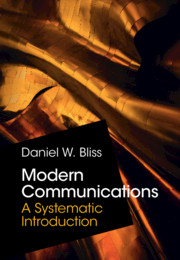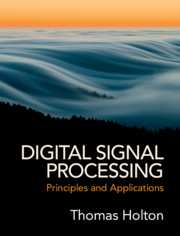Refine listing
Actions for selected content:
9096 results in Communications, Signal Processing and Information Theory
1 - Introduction
-
- Book:
- Compressive Imaging: Structure, Sampling, Learning
- Published online:
- 16 July 2021
- Print publication:
- 16 September 2021, pp 1-26
-
- Chapter
- Export citation
Abbreviations
-
- Book:
- Compressive Imaging: Structure, Sampling, Learning
- Published online:
- 16 July 2021
- Print publication:
- 16 September 2021, pp 567-567
-
- Chapter
- Export citation
13 - Local Structure and Uniform Recovery
- from PART III - Compressed Sensing with Local Structure
-
- Book:
- Compressive Imaging: Structure, Sampling, Learning
- Published online:
- 16 July 2021
- Print publication:
- 16 September 2021, pp 305-333
-
- Chapter
- Export citation
7 - Optimization for Compressed Sensing
- from Part II - Compressed Sensing, Optimization and Wavelets
-
- Book:
- Compressive Imaging: Structure, Sampling, Learning
- Published online:
- 16 July 2021
- Print publication:
- 16 September 2021, pp 142-165
-
- Chapter
- Export citation
Contents
-
- Book:
- Compressive Imaging: Structure, Sampling, Learning
- Published online:
- 16 July 2021
- Print publication:
- 16 September 2021, pp vii-xii
-
- Chapter
- Export citation
Appendix A - Linear Algebra
- from Appendices
-
- Book:
- Compressive Imaging: Structure, Sampling, Learning
- Published online:
- 16 July 2021
- Print publication:
- 16 September 2021, pp 528-536
-
- Chapter
- Export citation

Modern Communications
- A Systematic Introduction
-
- Published online:
- 18 August 2021
- Print publication:
- 22 July 2021
-
- Textbook
- Export citation

Digital Signal Processing
- Principles and Applications
-
- Published online:
- 24 July 2021
- Print publication:
- 14 January 2021
-
- Textbook
- Export citation
References
-
- Book:
- Modern Communications
- Published online:
- 18 August 2021
- Print publication:
- 22 July 2021, pp 262-263
-
- Chapter
- Export citation
14 - Probability and Statistics
- from Part II - Mathematical Background
-
- Book:
- Modern Communications
- Published online:
- 18 August 2021
- Print publication:
- 22 July 2021, pp 221-236
-
- Chapter
- Export citation
13 - Dynamic Chinese Restaurant Game: Sequential Decision-Making in Dynamic Systems
- from Part III - Sequential Decision-Making
-
- Book:
- Reciprocity, Evolution, and Decision Games in Network and Data Science
- Published online:
- 01 July 2021
- Print publication:
- 22 July 2021, pp 281-309
-
- Chapter
- Export citation
Preface
-
- Book:
- Modern Communications
- Published online:
- 18 August 2021
- Print publication:
- 22 July 2021, pp ix-xi
-
- Chapter
- Export citation
6 - Modulation and Demodulation
- from Part I - Communications Systems
-
- Book:
- Modern Communications
- Published online:
- 18 August 2021
- Print publication:
- 22 July 2021, pp 76-98
-
- Chapter
- Export citation
Acknowledgments
-
- Book:
- Modern Communications
- Published online:
- 18 August 2021
- Print publication:
- 22 July 2021, pp xii-xii
-
- Chapter
- Export citation
12 - Analog Radio Systems
- from Part I - Communications Systems
-
- Book:
- Modern Communications
- Published online:
- 18 August 2021
- Print publication:
- 22 July 2021, pp 176-188
-
- Chapter
- Export citation
7 - Dispersive Channels
- from Part I - Communications Systems
-
- Book:
- Modern Communications
- Published online:
- 18 August 2021
- Print publication:
- 22 July 2021, pp 99-124
-
- Chapter
- Export citation
6 - Evolutionary Game for Cooperative Peer-to-Peer Streaming
- from Part II - Evolutionary Games
-
- Book:
- Reciprocity, Evolution, and Decision Games in Network and Data Science
- Published online:
- 01 July 2021
- Print publication:
- 22 July 2021, pp 109-130
-
- Chapter
- Export citation
Part II - Evolutionary Games
-
- Book:
- Reciprocity, Evolution, and Decision Games in Network and Data Science
- Published online:
- 01 July 2021
- Print publication:
- 22 July 2021, pp 107-108
-
- Chapter
- Export citation
Contents
-
- Book:
- Reciprocity, Evolution, and Decision Games in Network and Data Science
- Published online:
- 01 July 2021
- Print publication:
- 22 July 2021, pp v-xii
-
- Chapter
- Export citation
Part I - Communications Systems
-
- Book:
- Modern Communications
- Published online:
- 18 August 2021
- Print publication:
- 22 July 2021, pp 1-188
-
- Chapter
- Export citation
